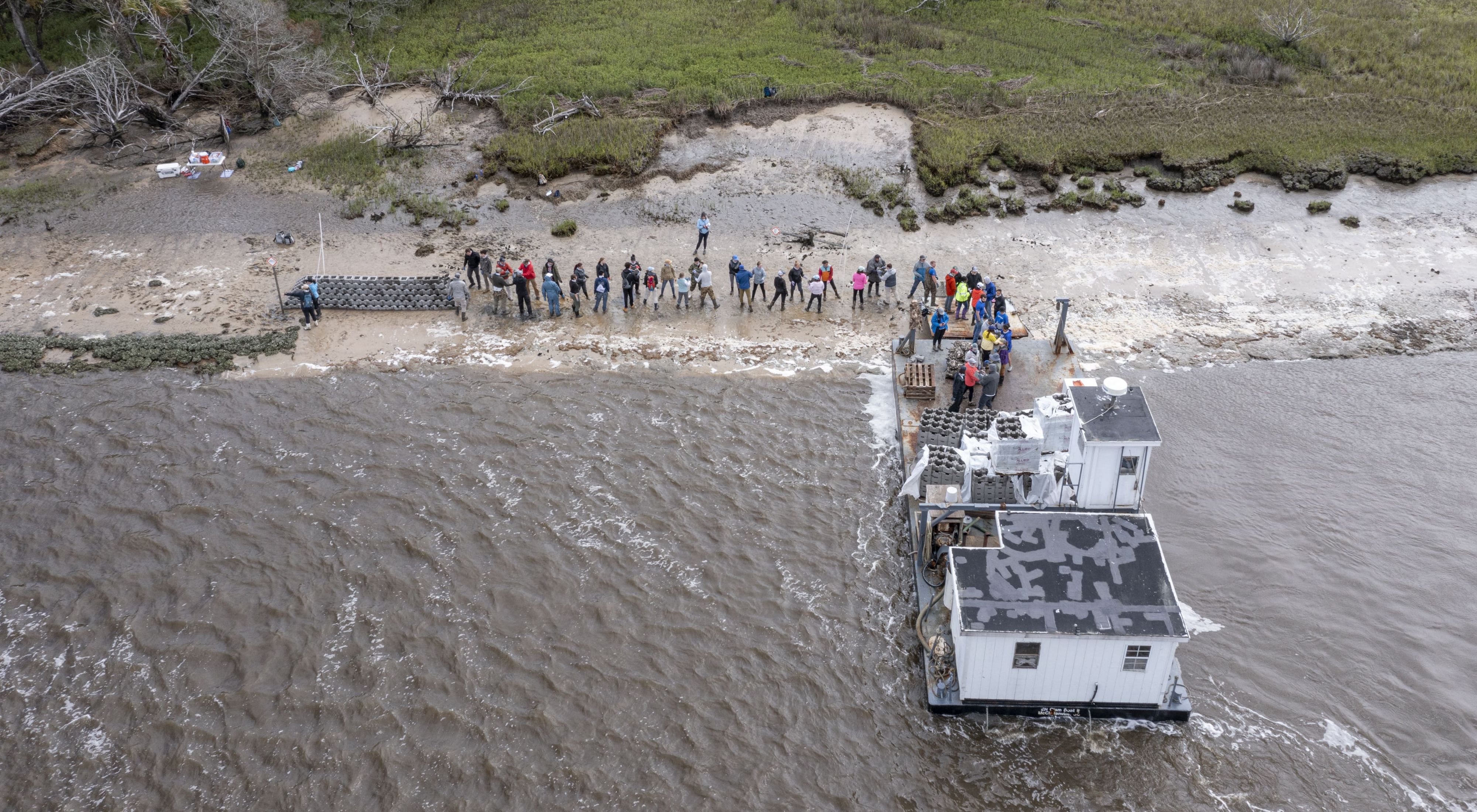The Nature Conservancy Receives $6.2 Million NOAA Grant
The grant supports efforts to build resilience along South Carolina's coast.
Media Contacts
-
Jennifer Howard
Steward Terra Communications
Phone: 843-709-4192
Email: jen@stewardterra.com
The Nature Conservancy has been selected to receive a $6.2 million grant from the National Oceanic and Atmospheric Administration's (NOAA) Transformational Habitat and Coastal Resilience program. The grant will support a three-pronged approach to scaling up the use of living shorelines to strengthen South Carolina’s coastal resilience:
- The installation and monitoring of the largest oyster-castle living shoreline in South Carolina, adjacent to Department of Defense (DOD) infrastructure. This planned 2,000-foot reef will be built with concrete oyster castles and will primarily protect the Laurel Bay area in Beaufort, which houses personnel for the Marine Corps Air Station.
- Accelerate existing efforts to implement living shoreline projects in underserved communities in Jasper, Colleton, Georgetown and Horry counties through a partnership with the South Carolina Office of Resilience (SCOR) and Gullah Geechee Cultural Heritage Corridor.
- Work with stakeholder groups on a two-year planning process to develop a 10-year vision for coastal resilience projects in South Carolina, focusing on living shorelines.
The 2019 South Carolina Floodwater Commission Report emphasized the connection between coastal ecosystems and coastal communities and called for an immediate scaling up of living shorelines for their direct impact in safeguarding coastal communities.
“Volunteers, conservation organizations and government entities have worked for 20 years building living shorelines one bag and one block at a time," commented Dale Threatt-Taylor, TNC's executive director in South Carolina. “Those efforts are making a real difference, but we need to significantly scale up our work to keep pace with more intense storms and rising sea levels. Our coastal communities depend on it.”
This funding is part of a larger NOAA announcement under the Bipartisan Infrastructure Law. The projects will help strengthen the climate resilience of coastal ecosystems and communities across the country.
“Living shorelines and other nature-based solutions provide coastal communities with critical protection from storms, sea-level rise and erosion,” said Carrie Selberg Robinson, director of the NOAA Fisheries Office of Habitat Conservation. “NOAA is proud to be supporting The Nature Conservancy's important work to expand the use of nature-based solutions in South Carolina and help protect historically underserved communities from the impacts of climate change."
The Floodwater Commission Report also recommended the creation of the South Carolina Office of Resilience to address the immediate needs of communities and implement long-term solutions to address environmental changes and natural hazards. The office is responsible for planning and coordinating statewide resilience, long-term recovery and hazard mitigation. In July 2023, SCOR will release the first Strategic Statewide Resilience and Risk Reduction Plan.
“SCOR is excited to support this effort as part of our mission to coordinate statewide resilience with partners like TNC and to support underserved communities along the coast that have been disproportionately impacted by environmental change and natural hazards,” commented Ben Duncan, the South Carolina Office of Resilience's chief resilience officer.
In the first year of the project, 2,000 feet of living shoreline will be installed adjacent to the Marine Corps Air Station (MCAS) on the Broad River in Beaufort. The MCAS was established during World War II for advanced submarine training. Today, the installation continues to support operations for the 2nd Marine Aircraft Wing, attached II MEF units and Marine Corps Recruit Depot Parris Island/Eastern Recruiting Region in order to set the conditions for the enduring success of their supported commands and missions.
MCAS Beaufort recognizes the close interconnectivity of their resilience and adaptive capacity within this tri-command area and has been a herald for the need for investments in strategic and cooperative land use and resilience planning with partners. This project not only complements resilience efforts aboard MCAS Beaufort but encapsulates the goals of the Lowcountry Sentinel Landscape partnership to connect military and community partners and strengthen military and coastal resilience by promoting activities outside the fence line that reduce vulnerabilities to climate change, protect critical infrastructure and help sustain military mission capabilities.
“For nearly 20 years, the strength and reliability of MCAS Beaufort's partnership in encroachment protection has been a mainstay within the broader landscape-scale conservation efforts in the Lowcountry region of South Carolina,” says David Trail, MCAS Beaufort director of government and external affairs. “We are eager to build upon our past successes by expanding our partnership with The Nature Conservancy and leveraging a broader coalition of stakeholders, resources and innovative planning to fully realize our mutually beneficial objectives and continue to enhance and strengthen the resiliency of our military installations and our Lowcountry community.”
TNC has installed more than a dozen living shorelines in South Carolina since the early 2000s, ranging from 50 feet to 250 feet in length. These pilot projects protected parcel-sized areas of coast while also providing valuable data on material use, site selection and habitat impact. In 2019, TNC embarked on its largest project yet—the future Boyd Living Shoreline in Georgetown—that was notable not only for its much larger size (one acre) but also the use of social vulnerability data in choosing an installation site. That data included nearby Opportunity Zones, hurricane evacuation routes and critical facilities in addition to on-the-ground site erosion. TNC also created a Community Ambassadors program around the project, inviting neighbors, businesses owners and community leaders to help shape the project.
The Nature Conservancy is a global conservation organization dedicated to conserving the lands and waters on which all life depends. Guided by science, we create innovative, on-the-ground solutions to our world’s toughest challenges so that nature and people can thrive together. We are tackling climate change, conserving lands, waters and oceans at an unprecedented scale, providing food and water sustainably and helping make cities more sustainable. Working in more than 70 countries and territories, we use a collaborative approach that engages local communities, governments, the private sector, and other partners. To learn more, visit nature.org or follow @nature_press on Twitter.
